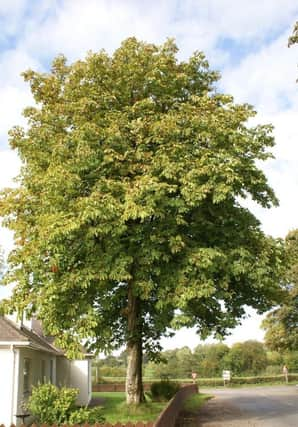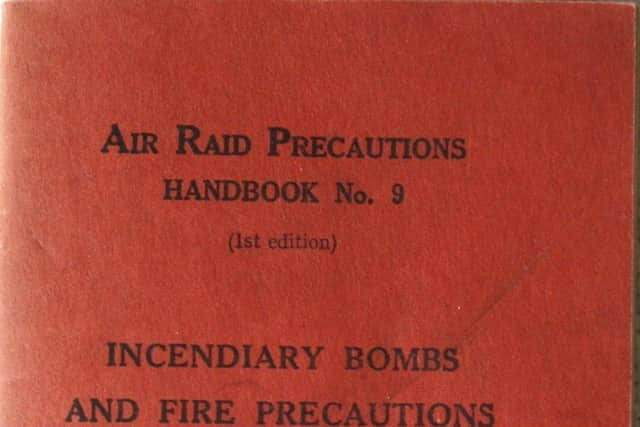It will soon be exactly 80 years since the World War II ‘Blitz on Belfast’


Like everything else amidst the current pandemic, public gatherings are disallowed or are very severely restricted, but there are numerous on-line and streamed events, and some small, private commemorations.
Roamer’s page has often shared News Letter readers’ memories of the blitz including accounts passed down through the generations, from Belfast and from country areas where city evacuees were sent for safety.
Advertisement
Hide AdAdvertisement
Hide AdA decade ago there was an endearing story here about two little Belfast brothers, evacuated to Tyrone.


They spent the war there and when it ended, on the day they returned to Belfast, they planted a single chestnut beside a country lane they often walked.
It grew into a magnificent tree and Roamer often tried to trace the boys who planted it. I never found them, and now their tree has gone.
In the run up to the 80th anniversary of the Belfast Blitz, if there are any more stories to share here please e-mail them to Roamer’s mailbox. In the meantime, several from the archives.
Advertisement
Hide AdAdvertisement
Hide AdAs a prime manufacturer of ships, planes, tanks and all sorts of weaponry and vital supplies during WWII, it was inevitable that Belfast would come under enemy attack.
The exact figures vary but around 1,000 people lost their lives in four German air raids on the city between 7 April and 6 May 1941.A substantial percentage of Belfast’s homes, buildings and infrastructure was damaged or destroyed.
For around five hours during the Easter Tuesday blitz on 15/16 April around 180 enemy aircraft dropped hundreds of bombs and thousands of incendiaries, mainly on residential areas in the city’s docklands.
During a three-hour raid on 4/5 May over 200 bombers deposited a further 237 tons of high explosives and 96,000 incendiaries on the city.
Advertisement
Hide AdAdvertisement
Hide AdThe Northern Ireland War Memorial Museum (niwarmemorial.org) hosts a permanent exhibition about WWII and the Easter blitz and along with a number of other local organisations it’s hosting a special ‘Blitz 80’ series of on-line events and exhibitions.
Some years ago a copy of the museum’s original Ordnance Survey map used by Hitler’s air-crews to target Belfast was reproduced here.
The ‘Stadtplan von Belfast’ is an extremely poignant document - ‘a map of mayhem’.
Measuring 110cm by 70cm, enemy strategists and Luftwaffe officers overprinted the ‘Stadtplan von Belfast’ with a hit-list of what they regarded as important targets.
Advertisement
Hide AdAdvertisement
Hide AdOutlined and highlighted in red-pen on the faded, patched-together document are the German bombers’ principal objectives (Einzelobjekte) including the docks, railway stations and reservoirs.
German pilots and navigators, peering through their goggles at Stormont (Parlamentsgebäude und Ministerien) and the City Hall (Stadthalle) far below, must have wondered as they released their bombs on the shipyard (Werft von Harland and Wolff) how a German surname became associated with such a strategic enemy target!
Did a poised finger pause fleetingly on a bomb-release button?
On 30th November 1940 a lonesome German reconnaissance aircraft flying high over Belfast returned to Germany with enough evidence to rightly conclude that the city’s air-defences were sparse.
Advertisement
Hide AdAdvertisement
Hide AdThe plane brought back detailed aerial photographs and identified some important targets in Belfast - the Waterworks, the Power Station, Victoria Barracks, the Connswater Fuel Depot, the docks and shipyards, Short and Harland’s aircraft factory and the Rank and Co. Flour Mill.
The original ‘Stadtplan von Belfast’ reproduced again here today was found in Gatow air field in Berlin by the RAF when they arrived there in 1945. Along with other landmarks like the City Hall, bridges, schools and even a confectionary factory, the targets were highlighted and listed on the map and were easily recognised by the German pilots, navigators and bomb aimers in 1941.
Belfast was ill-prepared for the Luftwaffe bombardment.
A regular contributor to this page, Mitchell Smyth, shared a vivid account here several years ago.
“There were only 200 public air raid shelters and no searchlights: not one. And no RAF planes took off on the night of the biggest raid to engage the bombers. It is said they didn’t want to get in the way of the anti-aircraft guns, but for whatever reason the guns didn’t go off.”
Advertisement
Hide AdAdvertisement
Hide AdMitchell also told us that before the Easter Tuesday attack “the Nazi broadcast propagandist William Joyce (‘Lord Haw Haw’) couldn’t resist taunting the people: he announced a few days previously in his broadcast from Hamburg that Belfast could expect ‘some Easter eggs.’”
Roamer has also received two original, Air Raid Precautions (ARP) handbooks which were hugely poignant to peruse - The Duties of Air Raid Wardens (second edition) published in 1938, and Incendiary Bombs and Fire Precautions (first edition), printed in 1939.
The handbooks were the eighth and ninth in a series of around a dozen publications issued by the Home Office and produced by His Majesty’s Publishing Office that outlined “measures for safeguarding the civil population against the effects of air attacks” and were printed along with a similar number of ARP booklets, pamphlets and memoranda, the latter “dealing with various aspects of the organisation to be provided by local authorities”.
There’ll be more Belfast Blitz memories and 80th anniversary information here very shortly.
A message from the Editor:
Advertisement
Hide AdAdvertisement
Hide AdThank you for reading this story on our website. While I have your attention, I also have an important request to make of you.
In order for us to continue to provide high quality and trusted local news on this free-to-read site, I am asking you to also please purchase a copy of our newspaper whenever you are able to do so.
Our journalists are highly trained and our content is independently regulated by IPSO to some of the most rigorous standards in the world. But being your eyes and ears comes at a price. So we need your support more than ever to buy our newspapers during this crisis.
With the coronavirus lockdown having a major impact on many of our local valued advertisers - and consequently the advertising that we receive - we are more reliant than ever on you helping us to provide you with news and information by buying a copy of our newspaper when you can safely.
Advertisement
Hide AdAdvertisement
Hide AdYou can also enjoy unlimited access to the best news from across Northern Ireland and the UK by subscribing to newsletter.co.uk
With a digital subscription, you can read more than five articles, see fewer ads, enjoy faster load times, and get access to exclusive newsletters and content. Visit https://www.newsletter.co.uk/subscriptions now to sign up.
Thank you